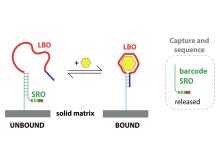BACKGROUND AND TECHNOLOGY
Small molecules like metabolites and drugs are at the core of healthcare. The levels of vitamins, hormones, sugars and other critical metabolites gives a snapshot of our health and small molecules like antibiotics, cancer drugs, and antidepressants are vital for treating disease. However, detecting these diverse small molecules is a massive bottleneck in every area of healthcare and medical research — this is what our new technology will change.
The problem: small molecules are hard to detect because every molecule is chemically different. Currently, all industries rely on one core technology: mass spectrometry. This platform is essentially unchanged in 60 years and requires highly trained technicians operating million dollar equipment in specialized diagnostics labs. It is slow, expensive, and inaccessible and it is a major bottleneck across many sectors. There has been a million-fold increase in DNA sequencing speed but there has been no equivalent change in our ability to see metabolites and drugs. We need a new technology to transform small molecule detection.
Our vision: we have developed a new technology that allows us to detect small molecules using DNA sequencing instead of mass spectroscopy. We use small DNA sensors called aptamers to detect each small molecule — different aptamers detect different small molecule targets with high specificity and when any target is detected it gives a unique signal in the form of a DNA sequence readout. At its core, our technology enables us to achieve two unmet needs in molecular diagnostics and synthetic biology: 1) the ability to detect thousands of molecules in parallel with DNA sequencing, and 2) the ability to identify a sensor for any small molecule target of choice. Together, this will lead to a powerful modern platform for small molecule detection that can revolutionize multiple areas of healthcare, from point-of-care diagnostics to drug discovery and synthesis using synthetic biology.

Figure 1. Metabolomics using aptamers and DNA barcoding. Binding of a small molecule to an aptamer sensor induces a conformational change that releases a specific DNA sequence or ‘barcode’. There is a specific sensor for each different target and each sensor releases a different barcode. Sequencing the released barcodes measures the levels of each target and thousands of targets can be read in parallel.
COMPETITIVE ADVANTAGE
- DNA sequence readout can be highly amplified
- Mass spectrometry has limits to sensitivity which makes detection of low levels of molecules very challenging – DNA sequences can be amplified millions of fold
- Platform harnesses the power of DNA sequencing
- Throughput, accessibility, and power of DNA sequencing far exceeds mass spectrometry
- DNA sequence-based detection allows point-of-care applications
- Multiplexed detection
- Thousands of sensors can be analyzed in parallel – each has a different sequence readout
APPLICATIONS
- Metabolomics
- Potential for single cell metabolomics
- Small Molecule Detection
- Synthetic biology
- Personal point-of-care diagnostics
INTELLECTUAL PROPERTY STATUS
- PCT Application (November 2022)
PROJECT STATUS
The core technology has been highly validated in proof-of-concept experiments. Aptamers with DNA sequence readouts can detect a wide range of drugs (e.g. antibiotics, antimalarials) and metabolites (sugars, hormones, amino acids) and can detect their targets in parallel. The specificity of the sensors is high e.g. sensors distinguish between individual amino acids, different highly related antibiotics, and even between stereoisomers. They have raised almost $1M in government funding and have industry collaborations with international partners.





